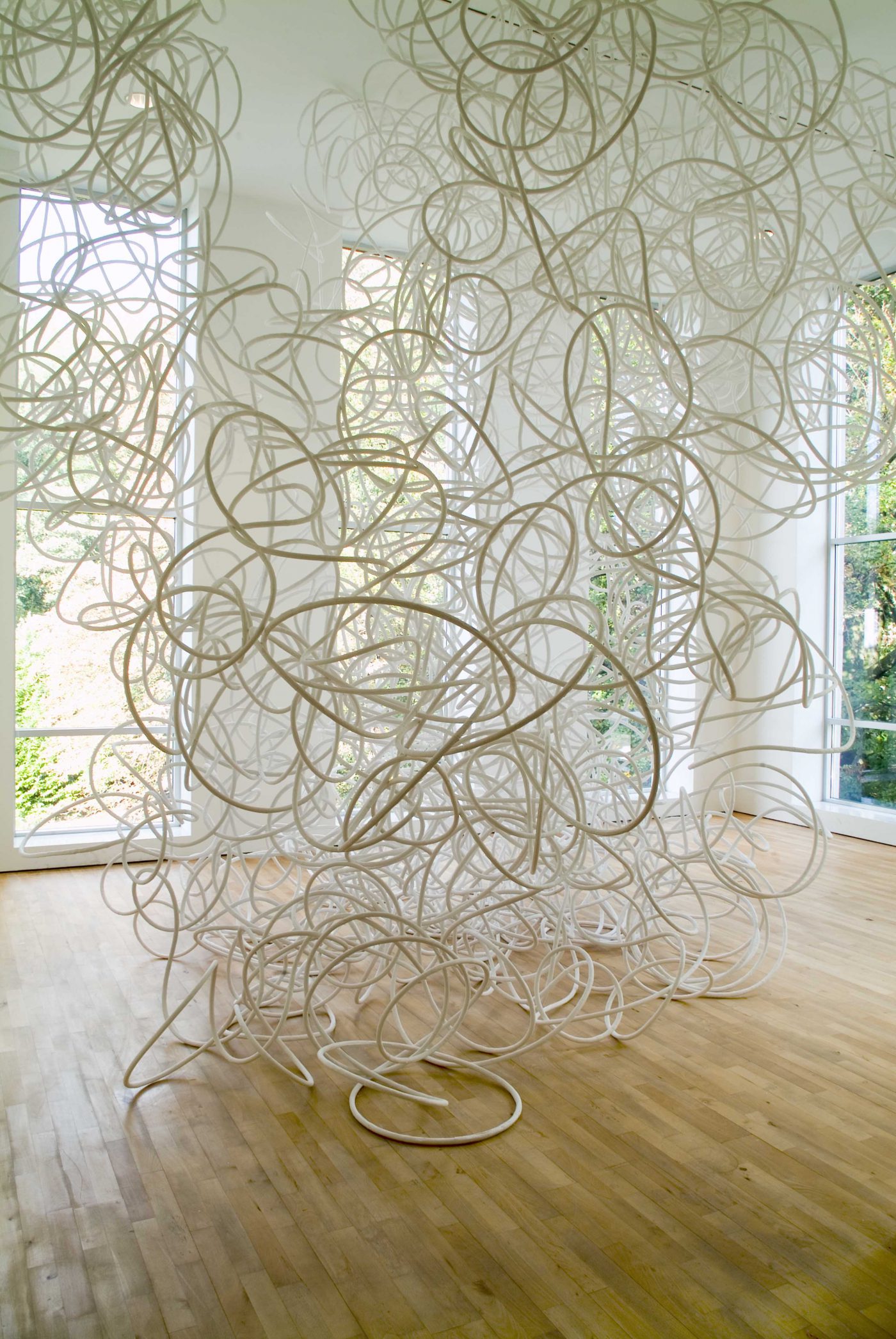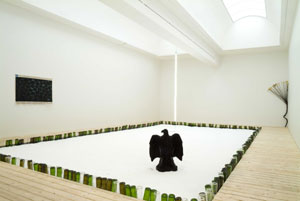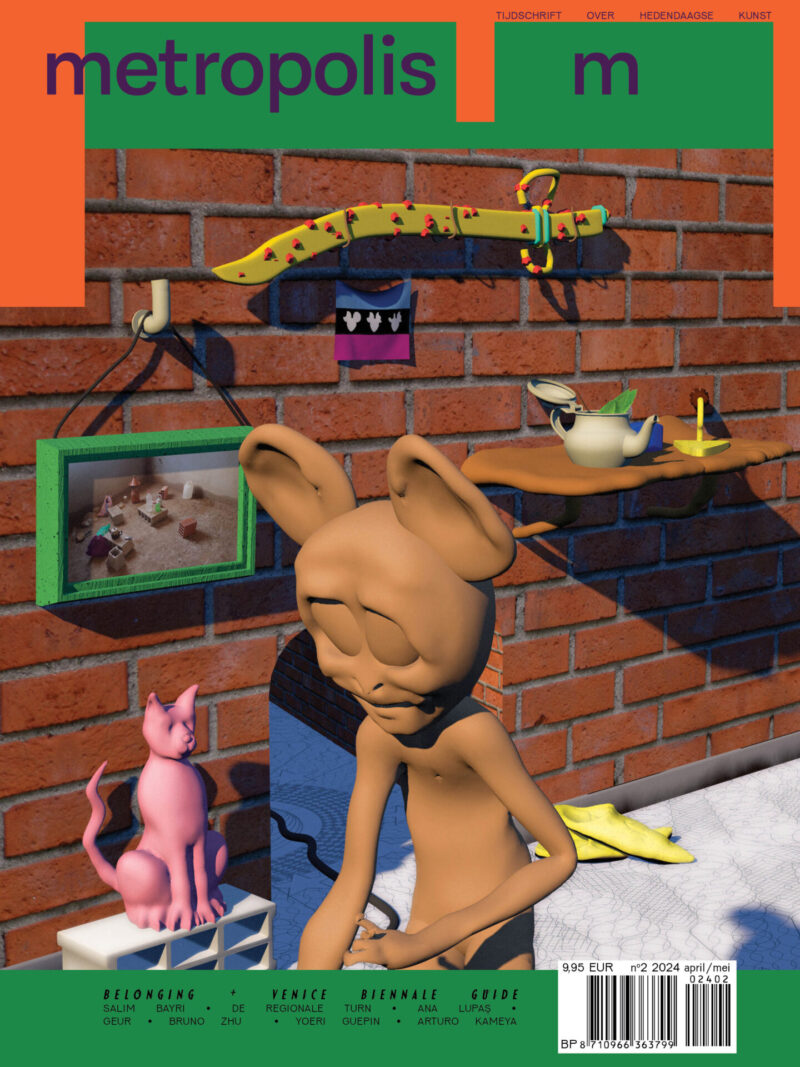
Final Days: Michel François at S.M.A.K.

In a world run by economics and commerce the work of Michel François asks some hard and penetrating but mostly beautiful questions. Plans d’évasion, a huge retrospective which sprawls over the eleven rooms and halls of the entire first floor of the S.M.A.K. in Ghent, is conceived like a journey through the material processes of human inventiveness and creativity. Endlessly recycling discarded materials, elemental resources and seemingly valueless matter this exhibition shows how we both make and unmake the human world we inhabit and how this reflects the simple beauty and essential fragility of humanity.
Marxist Transformations
The amount of material Michel François has amassed for this retrospective is massive, especially in the seventh room, which is at the heart of the exhibition and assembles over two dozen pieces, ranging from small sculptures to room-size installations, all of which interact with each other through holes in fake walls, mirrors within works and pieces that are so near to each other that they seem to blend. The entire exhibition is permeated by a sense of playfulness and lightness, but without the smug cleverness that this often entails in postmodern installations.
François’ art is sometimes tongue in cheek, yes, but it is also unashamedly romantic and feels passionately about what it stands for. It never keeps its distance and always relates to you, the spectator, as a human being, a person, and someone with the world-transforming capacities that François’ work is all about. In fact, walking through Plans d’évasion one is slowly engulfed by the experience and ends up feeling thoroughly and comfortably at home in this unique universe, which is at once highly critical and sublimely poetic.
All too often these days, installation art ends up being dire, with spectators stating at everyday objects, knowing not what to think of it, but clearly aware of the fact that it must be art since it is set up within a museum. So people stand around the object and try to look pensive, serious and grave. After all, the culture is being critiqued! None of this with the work of François. The overwhelming presence of his huge installations and environments never becomes oppressive. On the contrary, the works reach out to us and invite us into their world. With so much bad art about it would seem to be very difficult to create successful installations. And yet François makes it seem so easy, so simple, so self-evident.
But it isn’t. In fact, there are many threads running through this oeuvre, ideological and philosophical veins that connect these eleven rooms and through which the lifeblood of this art flows. A central concern of the installation (for this sprawling retrospective is indeed conceived as one huge walk-in installation) is the way we transform matter into meaningful worlds. This is world-making, the most human of activities. But all transformation starts with resources, the base materials and natural stuffs upon which we labour to make things and build an inhabitable world.
This creative aspect of mankind is visible in François’ choice of materials. Because he is constantly referring to the processes of recycling and transformation that govern both the human and the natural world François often uses or refers to the very basic materials or resources used to produce goods: wood, paper and polystyrene are omnipresent as elementary industrial products, but they are always put to a use that takes them out of their industrial environment and applies them for maximal poetic effect. The most elementary way of transforming materials is through the use of water, fire or wind, each of which are present in this exhibition. That way François stresses the organic aspect of transformation and industry, referring back to Marx’s insight that all transformation through labour is in effect a kind of alchemy whereby baser materials are magically changed into objects of value.
This process is reflected in Instant gratification (territoire morselé) (2009), which is a rectangular pattern on the floor made of over-lifesize silver bars. But these silver bars are really made of black clay wrapped in aluminium foil. They are as fake (but, being art, as valuable) as an interstellar Warhol candy-bar. On the edges of the rectangle greedy hands have clawed open several of the bars, revealing the black clay inside. In Das Kapital (1867) Marx writes about the magical way silver and gold are extracted from the bowels of the earth and come to represent an absolute standard of value because their purity assures that their value is constant in every part. An ounce of gold has the same relative value as a pound of gold and any amount of gold can be melted down and recast without losing its value. What seems to fascinate Marx the most is the fact that both silver and gold are brought to light from inside the earth through human labour, and in this sense they are not different from or more valuable than any other mineral. In nature gold is not more valuable than rock: both are simply there. François reveals this material aspect of money and its value: the silver or gold we greedily grope for is, in the end, dirt, which is represented here by the black clay. And the black colour of the clay can surely be taken as a further reference to that other black gold: oil, which erupts from the earth in a geyser-like way in capitalist fantasies such as Dallas or Dynasty.
Natural forces are omnipresent in the exhibition (and it should be noted that man’s labour force, and thus his ability to transform matter, is also a natural force) through the workings of the elements. A flag can be seen floating on an artificial gust of wind. Two rooms are organised around burnt-out books. And the destructive force of the elements combined is suggested in a huge installation which is part of the seventh room. It shows a big space cluttered with what look like the remains of a collapsed chipboard building with a single trickle of water endlessly dripping down as if to mock the aftermath of disaster. Nature, if she pleases, can destroy man’s creations in the blink of an eye. But these natural forces can also be put to creative use. This is shown to stunning effect in another room which is entirely filled with Pièce détachée (2009), an elaborate construction of steel balls and bars that seem to hover in mid-air with only the feeblest of connections to the walls. In fact, this steel construction is kept in place through the forces of a magnetic field, which is a wonderful illustration of man’s ability to bend nature’s forces to his own uses.
Still, François never allows us to forget the fragile nature of our world. His most telling reminder is the juxtaposition of two fascinating pieces within one room. The first piece is Golden Cage I (2008), a gilded metal cage that looks as if it were made of leather straps because the grid of the cage seems slack and slightly sagging. It is almost a mockery of Jeff Koons, who casts capitalist icons, from toy trains to inflatable rabbits, in stainless steel. François’ golden cage is more visually romantic, with its unforgiving yet seductive texture of gold-tinted metal, and more semantically austere, literally representing the gilded cage we construct for ourselves when we live for greed.
Next to this piece lies Walk through a line of neon lights (2004-2009), a path of several dozens of neon lights that are broken and crushed in the middle, cutting a path from one end to the other. There is a wonderful poetry in shattered glass because it so vividly evokes the brittle nature of all made things. This theme is also taken up in a slow-motion video that shows a man walking around while empty wine bottles fall to the ground and shatter around him. The camera is posited ninety degrees above the ground, giving us a bird’s eye view of the proceedings. The sound of breaking glass is amplified to a degree that is on the verge of being uncomfortable. This way, a sense of threat and imminent disaster (will the next bottle hit him?) slowly creeps up on you.

Gardens of Dead Flowers
Three rooms can be taken to represent the core of this exhibition. The first, which is also the largest and most impressive, is the main hall of the museum’s first floor. On the main wall, which faces a glass wall overlooking the park and streets in front of the museum, François has chiselled the legend ‘Pas tomber!’ in huge but elegant letters. The plaster that was cut away has been left on the floor, a trace of the labour involved in creating the work. But this inscription is not the first thing one sees upon entering the hall, for a series of cords span the room from wall to wall like a series of clotheslines. From these lines dandelions hang. But all the flowers have run to seed, leaving the typical white globe of soft floating seeds that children love to blow off the stem. Literally hundreds of these dried flowers hang from the clotheslines, but not a single seed seems to have fallen. Together these flowers make for a perfect sky. As a work of art it is of a most delicate nature and reminds us again, but now with great emotive force, of the sheer beauty and delicacy of our world, both the natural and human worlds. In her wonderful book On Beauty and Being Just (1999) Elaine Scarry writes about how easy it is for us to destroy a field of flowers: all we have to do is step upon them. There are people who would kick a tulip and destroy it for their sport. If we feel revulsion at such acts of random destruction it is because the sheer vulnerability of the flowers fills us with a desire to care for their beauty. It is Scarry’s thesis that this sensitivity to beauty is a powerful experience because it can be enlarged to take in the entire world, promoting in us a feeling of care for all things natural and human. To see the world as fragile is to want to keep it safe.
This sense of being at one with the world in the vulnerability we share with it inhabits the middle between two extremes: on the one hand the process of creation and fruition, on the other the process of destruction and decay. Both these extremes are represented in two twinned rooms that are placed at opposite ends of the exhibition, as if to stud everything in-between. Both rooms mirror each other and can be seen as counterparts.

